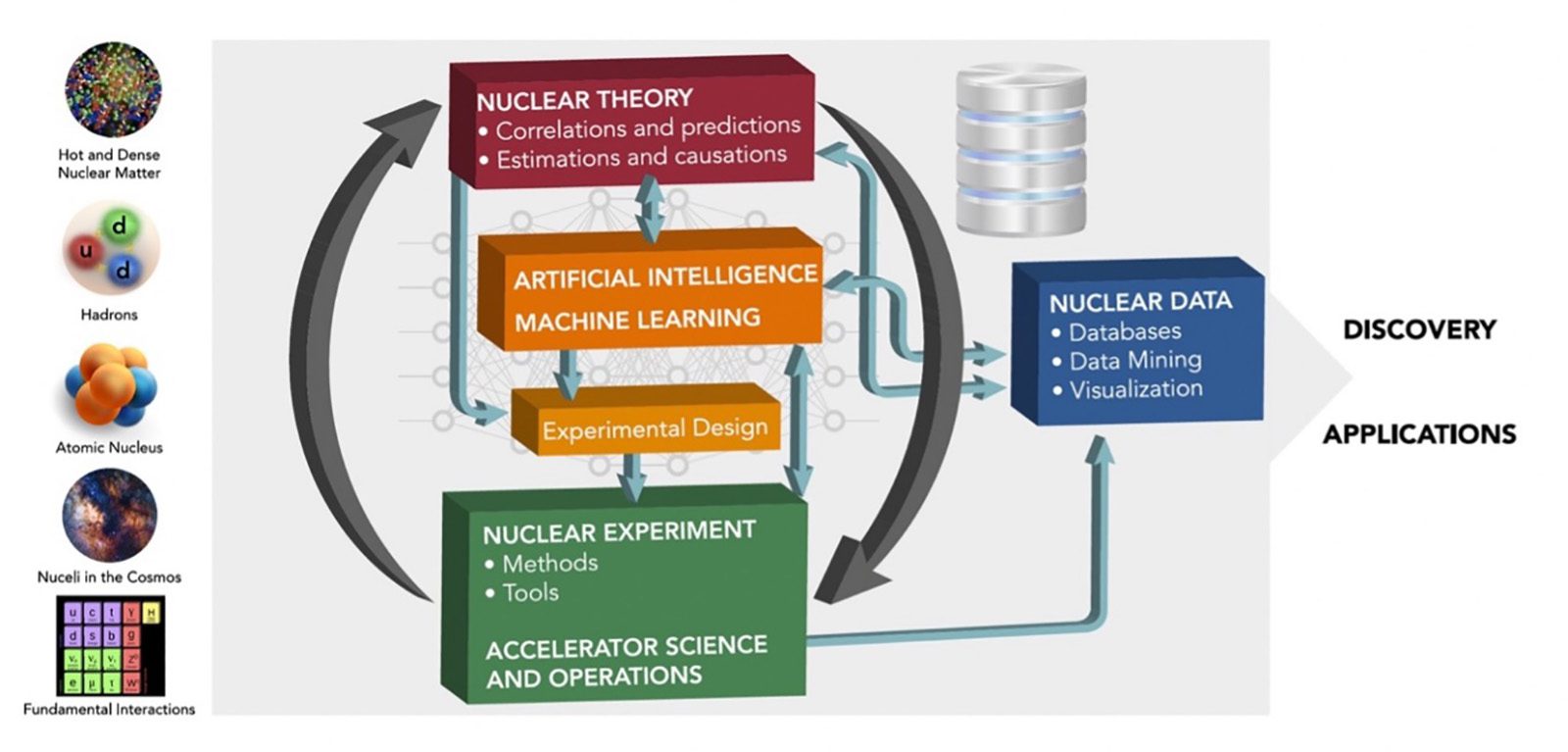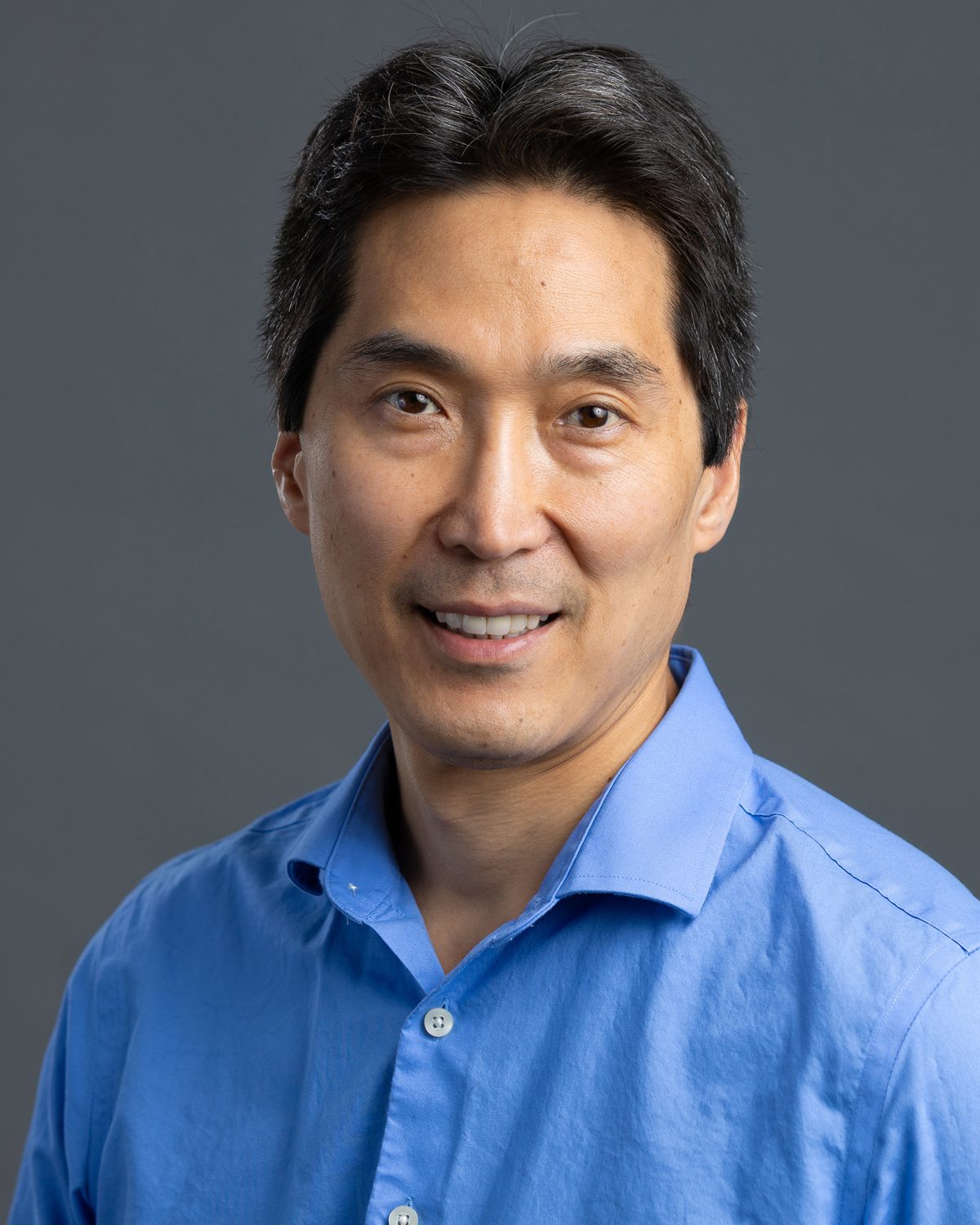The Facility for Rare Isotope Beams, or FRIB, at Michigan State University is home to a world-unique particle accelerator designed to push the boundaries of our understanding of nature.
Now, FRIB is accelerating that work with a form of artificial intelligence known as machine learning with support from the Office of Nuclear Physics, or NP, and the Office of High Energy Physics, or HEP, at the U.S. Department of Energy Office of Science, or DOE-SC.
“Artificial intelligence has the potential to shorten the timeline for experimental discovery in nuclear physics,” said Timothy Hallman, DOE associate director of science for Nuclear Physics. “Particle accelerator facilities and nuclear physics instrumentation face a variety of technical challenges in simulations, control, data acquisition and analysis that artificial intelligence holds promise to address.”
FRIB scientists have received several grants that aim to bring machine learning’s power to process immense data sets to bear in experiments, theoretical studies and the science and engineering that keeps the accelerator humming.

The grants will be led by Christopher Wrede, Dean Lee, Peter Ostroumov, and Yue Hao. All are professors at FRIB and in MSU’s Department of Physics and Astronomy in the College of Natural Science. Lee is the head of FRIB’s Theoretical Nuclear Science Department, and Ostroumov is the associate director of the FRIB Accelerator Systems Division.
With its grant “Machine Learning for Time Projection Chambers at FRIB,” Wrede’s team is working to shorten the time to discovery in experiments for nuclear astrophysics, helping better explain processes in stars.
For the grant supporting theoretical work, titled “STREAMLINE Collaboration: Machine Learning for Nuclear Many-Body Systems,” Lee and his colleagues are using machine learning in a variety of ways. The common goal is to accelerate the quest for a more robust understanding of the physics at work in the cores of atoms.
The third grant — “Online Autonomous Tuning of the FRIB Accelerator Using Machine Learning” — will have Ostroumov and his team leveraging massive amounts of operations data to help automate facility processes. In doing so, the team is working to minimize upkeep time and help more FRIB users conduct more science.
And Hao is leading two grants: One is titled “Development of Differentiable Beam Dynamics Simulation Tools Including Collective Effects for HEP Accelerator Applications” and the other is “Artificial Intelligence Application in Nonlinear Beam Dynamics Study for Future HEP Accelerators.”
Both will help computational studies better integrate and leverage the power of machine learning in accelerator physics. Hao’s grants were awarded by the Office of High Energy Physics, while those led by Lee, Wrede and Ostroumov were awarded by the Office of Nuclear Physics, both of which are part of DOE-SC.
FRIB is a DOE-SC user facility serving the global nuclear science research community. The work of these grants will help support that community and the DOE-SC mission to deliver transformative discoveries and scientific tools.
Beyond creating new knowledge and technology, DOE-SC and FRIB are also dedicated to training the next generation of nuclear scientists — an effort that the teams will work to strengthen with these new grants.
“AI and machine learning are hot topics,” Lee said. “They’re not just useful, they’re helping us recruit new students to the field.”
In addition to the five grants led by FRIB faculty, another award is supporting a collaboration between FRIB and Virginia State University. Led by Thomas Redpath, an assistant professor in VSU’S Department of Chemistry, the grant also enlists the services of Paul Guèye, associate professor of nuclear physics at FRIB and in MSU’s Department of Physics and Astronomy. The team’s project is titled “Neural Network Classifier for Analyzing Measurements of Fast Neutrons for Invariant Mass Spectroscopy.”
‘Is there a cat in that picture?’
Machine learning involves “teaching” an AI algorithm with massive amounts of data related to problems that are expensive, challenging or even impossible for humans to solve in a reasonable amount of time.

One popular and instructive example of such a problem involves cats.
More precisely, it’s about image analysis. Developers have trained machine learning algorithms with multitudes of photographs. That way, when the system is fed a new library of images, it can easily find ones that contain specific objects of interest, say cats.
This is almost exactly what Wrede will be doing in his new project. Only, instead of pictures of cats, he and his team will analyze images from a particle detector dubbed GADGET II. The AI will look for two “bumps” that are signatures of a rare nuclear decay.
“Our problem is actually simple compared to ‘Is there a cat in that picture?’” Wrede said. “We’re basically asking ‘Are there two bumps?’”
By investigating this rare decay, the team is developing a better understanding of a key nuclear reaction affecting cosmic phenomena known as X-ray bursts. An X-ray burst is the rapid release of X-rays from the surface of ultra-dense stars called neutron stars.
“A neutron star is so dense, it’s almost a black hole,” Wrede said.
Although it’s easy enough for a person to pick a cat or a couple bumps out of a single image, Wrede’s experiment generated nearly a billion potential candidates. The particle signature the researchers are interested in is expected to appear in, at most, 10 images out of that batch.
“It’s looking for a needle in a haystack,” Wrede said. “If we could automate that, it would be fantastic.”
Wrede and doctoral candidate Tyler Wheeler, a graduate assistant at FRIB, have already started working toward that goal in collaboration with Saiprasad Ravishankar, an assistant professor in the College of Engineering and the College of Natural Science. Ravishankar is also a co-principal investigator on the new grant, which will allow the team to augment its efforts.
Also joining the grant are Daniel Bazin, a research professor at FRIB, and Sijia Liu, an assistant professor in the Department of Computer Science and Engineering.
Machine learning in theory
Lee also invoked cats to help explain his grant, although in a slightly different way: If a machine learning algorithm knows what cats look like, it could also be used to create a brand new image of a cat.

It might seem like there are limitless possibilities of what this machine-made cat could look like, but a person would be able to discern very quickly whether that cat was realistic or not, Lee said. He and his collaborators are applying that rationale to machine learning in theoretical nuclear physics.
“The space of what’s possible seems infinite, but there’s only a comparatively small sliver of reasonable outcomes,” Lee said.
In one thrust of his grant, researchers will teach a machine learning algorithm about well-characterized isotopes and nuclear systems, analogous to the training data in the cat example.
They’ll then use that to predict the features of systems they’ve never seen before, akin to the made-up cat. Such predictions could prove very valuable at FRIB, which will produce more than 1,000 isotopes that scientists have never made or measured before.
Although predicting the unknown doesn’t require machine learning, AI can accelerate the work of understanding those rare isotopes when it’s in the hands of researchers who can recognize that sliver of reasonable outcomes.
The grant has additional goals, such as explaining how complex quantum systems change over time, finding the structure of exotic nuclei and probing new physics by performing thousands of variations on solved problems. In each case, machine learning can help the team cover more ground more quickly.
“The frontiers of nuclear theory live at the edge of scientific computability,” Lee said. “What machine learning does is let you go a little bit beyond the edge and open up new frontiers.”
Joining Lee on this grant from MSU and FRIB are Pablo Giuliani, research associate at FRIB; Kyle Godbey, research assistant professor at FRIB; Xilin Zhang, visiting assistant professor at FRIB; Morten Hjorth-Jensen, professor of physics at FRIB and in MSU’s Department of Physics and Astronomy; and Witold Nazarewicz, John A. Hannah Distinguished Professor of Physics and chief scientist at FRIB.
They’re collaborating with 10 more scientists from national labs and universities across the country, including Lee’s brother, Daniel Lee, a Tisch University Professor at Cornell University.
Automation of operations
It probably isn’t surprising to hear that FRIB’s particle accelerator — designed to be the most powerful heavy-ion accelerator — is a finely tuned instrument. Still, learning how much science, engineering and effort goes into keeping the machine tuned can be stunning.

In broad strokes, the underlying scientific strategy of FRIB is to accelerate a beam of heavy ions to at least half the speed of light. It then sends that beam barreling into a target material to create rare isotopes.
But there are a lot of specifics to address to ensure this process is optimized.
“As accelerator scientists, our main objectives are to set up the accelerator’s beam quickly and deliver it to the target without any unexpected losses,” Ostroumov said.
Experimentalists have a dozen different choices for which variety of heavy ion they would like to use in their beams, including some at various energies. Nine more choices are in development.
Each beam must be precisely tuned to hit the target just so: as focused as possible while losing as little power as possible before reaching the target. It thus takes time to tune the accelerator for new stable isotopes and to switch beams for new experiments.
That means there’s necessarily some down time while pushing the boundaries of nuclear science.
“Here’s where machine learning comes in,” Ostroumov said. “We’d like to reduce that time.”
Once the beam is optimally tuned, the machine learning algorithms will help maintain the beam’s stability and parameters on the target.
FRIB has a beam monitoring system that takes hundreds of measurements every few seconds. More than 1,000 variables within accelerating resonators and beamline devices can affect the beam properties.
By monitoring these, Ostroumov and his team keep tabs on the integrity of the beam and see when it needs a tune-up. The system is also generating a huge amount of data that could be used to train a machine learning algorithm to help automate the tuning process.
That would open up a future when more scientists are able to do more science more quickly. With FRIB being at MSU, the team will also be training the students capable of supporting and innovating in that future.
“I have a great team with very highly qualified people,” Ostroumov said. “We have faculty that will work with students — including undergraduates, since they are highly interested in machine learning — and help guide them.”
Computation to avoid chaos
The grants led by Hao are also supporting the development of AI applications in accelerator science. He and his team use computational modeling to study the physics inside beams of charged particles, which is applicable to FRIB as well as other particle accelerators around the globe.

One of Hao’s grants is dedicated to making his team’s conventional methods more efficient and more compatible with modern approaches that include machine learning.
“Our work will provide efficient computation method to automatically calculate the derivative of the output, so we enable faster optimization process,” Hao said. “We can more easily combine traditional methods with machine learning, so there’s no obvious barriers between the two.”
The second grant is a more direct application of machine learning to the physical problems Hao and his team are trying to solve, which are inherently complex and, to put it technically, nonlinear.
The nonlinear dynamics at work in the beam create two different conditions: one where the beam’s motion is stable and another where it’s chaotic.
“We don’t want chaotic motion. We want to make the stable region as large as possible,” Hao said. “If we can understand that better, we can potentially build higher performance accelerators.”
Nonlinear motion, however, can be incredibly complicated and very challenging to model and explain, even with computational help. But there’s a mathematical theorem that states that, under the right conditions, such complicated real-life motion can be transformed to a special space.
In this special space, the complex motion can be simplified to something familiar and much easier to describe mathematically, say, an oscillating spring. Researchers could then analyze and probe the motion in that simple space, then transform their findings back to the real world.
The problem here is that it’s also very challenging to find the transformations that unlock the door to that special space. And this is where Hao and his team want to apply machine learning.
“In this proposal, we’re trying to merge machine learning with that mathematical theorem,” Hao said. “Can we design a neural network structure that will find the transformations?”
Like the other grants in this story, both of Hao’s projects are connected by the concept of machine learning. But the connection between all of the projects goes a bit deeper than that. In a way, they’re all setting the stage for what the future of machine learning may look like in this realm of science.
“We’re trying to find the boundaries of what machine learning can do and what it can’t do,” Hao said.
This article was originally published by the College of Natural Science.
About the MSU Innovation Center:
The MSU Innovation Center is dedicated to fostering innovation, research commercialization, and entrepreneurial activities from the research and discovery happening across our campus every day. We act as the primary interface for researchers aiming to see their research applied to solving real-world problems and making the world a better place to live. We aim to empower faculty, researchers, and students within our community of scholars by providing them with the knowledge, skills, and opportunities to bring their discoveries to the forefront. Through strategic collaborations with the private sector, we aim to amplify the impact of faculty research and drive economic growth while positively impacting society. We foster mutually beneficial, long-term relationships with the private sector through corporate-sponsored research collaborations, technology licensing discussions, and support for faculty entrepreneurs to support the establishment of startup companies.
Is your organization interested in sponsoring further FRIB experimentation? Click Here.

